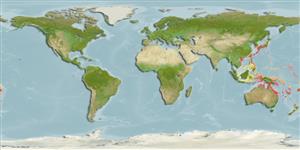Common names from other countries
>
Gobiesociformes (Clingfishes) >
Gobiesocidae (Clingfishes and singleslits) > Diademichthyinae
Etymology: Lepadichthys: Greek, lepas, -ados = limpet + Greek, ichtys = fish (Ref. 45335).
More on author: Waite.
Issue
Junior synonym Aspasma misakia (= Lepadichthys misakius) is a valid species acroding to Fujiwara & Motomura, 2019 (Ref. 119733). Information from this page will be corrected accordingly.
Environment: milieu / climate zone / depth range / distribution range
Ecologia
marino associati a barriera corallina; distribuzione batimetrica 1 - 6 m (Ref. 86942). Temperate
Southwestern Pacific: Thursday Island (Torres Strait Islands), Coral and Tasman seas (Australia, Vanuatu and New Caledonia), Fiji and Tonga.
Size / Peso / Age
Maturity: Lm ? range ? - ? cm
Max length : 5.7 cm SL maschio/sesso non determinato; (Ref. 38029)
Short description
Chiavi di identificazione | Morfologia | Morfometria
Spine dorsali (totale) : 0; Raggi dorsali molli (totale) : 15 - 17; Spine anali: 0; Raggi anali molli: 12 - 15. Dorsal and anal fins joined to the caudal fin (Ref. 42101).
Found on rocky shores and coral reefs, usually under Diadema setosum.
Life cycle and mating behavior
Maturities | Riproduzione | Spawnings | Egg(s) | Fecundities | Larve
Oviparous, distinct pairing during breeding (Ref. 205).
Masuda, H., K. Amaoka, C. Araga, T. Uyeno and T. Yoshino, 1984. The fishes of the Japanese Archipelago. Vol. 1. Tokai University Press, Tokyo, Japan. 437 p. (text). (Ref. 559)
IUCN Red List Status (Ref. 130435)
CITES (Ref. 128078)
Not Evaluated
Threat to humans
Harmless
Human uses
Strumenti
Special reports
Download XML
Fonti Internet
Estimates based on models
Preferred temperature (Ref.
115969): 20.5 - 28.9, mean 27.5 (based on 1261 cells).
Phylogenetic diversity index (Ref.
82804): PD
50 = 0.5005 [Uniqueness, from 0.5 = low to 2.0 = high].
Bayesian length-weight: a=0.00389 (0.00180 - 0.00842), b=3.12 (2.94 - 3.30), in cm Total Length, based on all LWR estimates for this body shape (Ref.
93245).
Trophic level (Ref.
69278): 3.7 ±0.3 se; based on size and trophs of closest relatives
Resilienza (Ref.
120179): Medio, tempo minimo di raddoppiamento della popolazione 1.4 - 4.4 anni (Preliminary K or Fecundity.).
Fishing Vulnerability (Ref.
59153): Low vulnerability (10 of 100).
